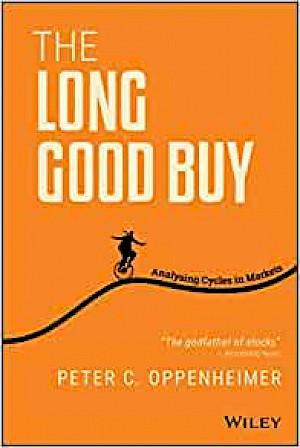23 July 2020
The Long Good Buy:
Analysing Cycles in Markets
Peter C Oppenheimer
2020, John Wiley & Sons Ltd, 304 pages,
ISBN 9781119688976
Reviewer: Lavan Mahadeva

This book with its terrific title is a guide to navigating the long-term volatility in equity markets with the argument that you need to step back and survey much more than the recent history of equities to make a good return.
Peter Oppenheimer argues that equity prices repeat phases of despair, hope, growth, and optimism. These phases reflect market psychology as market participants process imperfect macroeconomic and corporate data to anticipate when things will get better or worse. For example, during long growth phases, confidence is slowly regained following the structural problem that triggered past despair.
The rocket platform of the book is that valuations cycle above and below future fundamentals. As Oppenheimer outlines, if you bought equities at the end of the 1990s when there was strong economic data and profit growth, you would have been destroyed in the first few years of the new millennium that followed. The valuation metrics of the US equity market in late 1999 were at the highest of levels. He reminds us that Robert Shiller’s (CAPE) Price/Earnings ratio is negatively correlated with the next ten years of annualised returns. (Warning: his correlation would not be so high if he had used semi-log regression). Conversely, if you bought into US equity in summer of 1982, when the CAPE was at a low and even before unemployment peaked, but held for five years, returns would have been over twenty percent.
Oppenheimer argues that equity investments made during the hope phase typically yield the highest annualised returns and most of this is from price not earnings. Though indicators such as profits are still falling in this phase, they are bottoming out. But this is also the briefest of the four phases—while hope is only 9 months, then the growth phase takes over for 49 months, then optimism lasts about 23 months, then despair lasts about 16 months and so on. The book is not technical analysis: Oppenheimer does not suggest strategies that require predicting timing of these phases but wants us to think of this as a framework. Thus, though Oppenheimer argues that over the long run investing in equities can be extremely profitable, he does not contradict either Marx — capitalism can’t be stable — or the Efficient Market Hypothesis— returns can’t be easily predictable.
The book walks us though the 1970s, early 1980s, the 1990s, 2000 to 2007, and 2008 to 2019 cycles. There are neat comparisons with bull and bear markets of centuries past. Inflation, growth, fiscal and monetary policy play an important part. In the late 1970s, sharp rises in inflation and then tighter monetary policy to control that inflation lowered equity prices. Now in a low inflation-low interest rate environment, equity valuations should be more sensitive to growth and fiscal policy. Oppenheimer also discusses different types of corporate business models and how the share price of each type of firm should then respond across different phases. But not only that. My favourite chapter was on bubbles where he shows that the best indicators of a bubble were often ‘’soft’’ ones such as deregulation, financial innovation and a belief in a new era and technology. The last two chapters bring us closer to date with an analysis of the post-crisis landscape, ultra-low yields and technology, all of which shows us that we are always sailing in new waters, and only the market’s reaction to processing change is familiar.
Pretty much as soon as the book was published, the coronavirus pandemic struck us and a new chapter is already due. The wonderful SPE podcast conversations discuss what the virus could mean, but yet so much is uncertain. Shoe-horning this into Oppenheimer’s characterisations, I would see it as either an event-driven or a structural bear market threat to equities. Whether stock markets can avoid the latter deep slump must I think depend upon the extent the virus can be contained without necessitating a costly re-design or shrinkage of the world’s service sectors. My reading of the book is that we should expect that answers to this question will be processed by stock markets through familiar phases of despair, hope and growth.
Those who have worked in equity markets would be interested in matching this against their own experiences. Others would be interested in learning about how an equity market practitioner approaches cycles and how they relate to the rest of the economy. After reading the book, I think economists should count their age not in years but in the number of cycles they have worked through. But reading about past cycles is good short-cut to working through them, and it is healthy for the economist’s soul.
